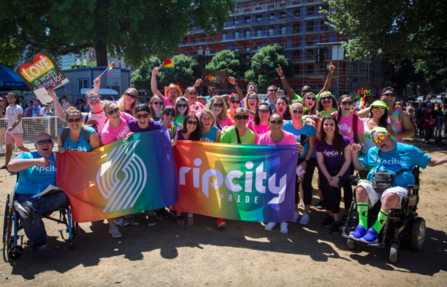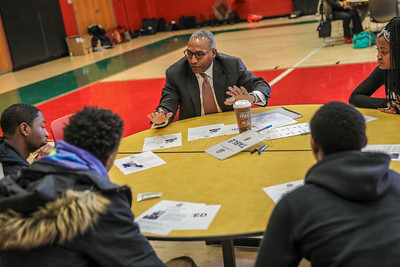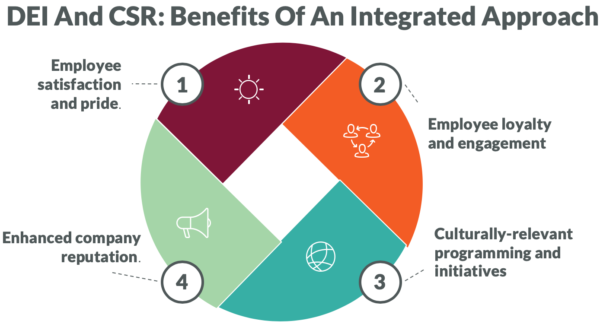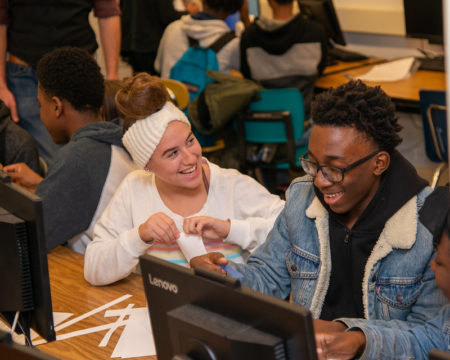How Diversity, Equity & Inclusion Should Inform Your Community Engagement Efforts
Rainbow streamers poured from the rafters of the Portland Trail Blazers’ arena. The NBA team’s December 2019 win capped a colorful celebration of its community’s diversity. Earlier in the night, the Trail Blazers raised thousands of dollars for a local LGBTQ+ community center and hosted a Pride-themed reception. Rainbows were everywhere: in the stands, on the court, and on the Trail Blazers’ mascot, Blaze the Trail Cat.
The Trail Blazers’ Pride Night is not a one-off day of celebration. Rather, it is one of the more visible ways that the team has combined community engagement with a year-round focus on diversity, equity, and inclusion (DEI).
In 2016, the Trail Blazers’ leadership made a conscious commitment to advance DEI within its organization and greater community. Following an all-staff training, the Trail Blazers inaugurated an Equity Team that comprised employees and executives across the company. Over the following 18 months, the Equity Team convened seven executive-led strategic planning committees to craft a new approach to their DEI and corporate social responsibility (CSR) initiatives. The efforts were coordinated by Christa Stout, the Trail Blazers’ Vice President of Innovation & Impact.
“The strategic planning committees provide a space for staff of all levels to learn about and implement additional ways to advance DEI within their sphere of influence,” Stout said. “Our goal is for all staff across the company to see themselves as champions and leaders of the work.”
The Power of Alignment
Research has shown that DEI is also a business advantage and a catalyst for innovation. Yet DEI strategy is typically siloed within the organization, often limiting its impact to Talent Management practices. A recent HR.com Research Institute report suggests that nearly three-fifths of HR professionals devote no more than 20% of their time to DEI initiatives. 44% of respondents said that their organization houses DEI in their Human Resources department.
These results demonstrate that leaders often miss opportunities to integrate DEI principles into other aspects of their business, including community engagement and corporate social responsibility (CSR) efforts.
The Portland Trail Blazers chose a more congruent strategy. The team’s leadership understands that diversity, equity, and inclusion should inform not only their internal culture-building initiatives but also their external community engagement efforts.
“Historically the work led by the Social Responsibility team focused on advancing equity across the region,” said Trail Blazers’ President Chris McGowan. “[W]e have a responsibility to utilize our platform and resources to be more intentional about our commitment to advancing DEI internally and externally.”
Conversations about historic and acute racial inequity have recently dominated international discourse. Organizations have responded through contributions to charitable organizations, supportive social media messages, and alliances with community organizations. Leading companies also recognize that they must align these efforts with investments in workplace equity.
Common Denominators
CSR operations tend to focus on external communities while DEI initiatives focus on internal communities. This distinction is counterproductive. Shared priorities allow CSR and DEI to mutually reinforce each other. Consider the following facts:
- Millennials are the largest segment of the workforce and represent a large part of your external community. Millennials are more inclined than preceding generations to expect that companies make public commitments to corporate citizenship and inclusion. According to a 2017 Glassdoor survey, 75% of employees aged 18-34 expect employers to take a stand on social issues.
- Consumers also say that companies have an obligation to take action to improve societal problems and historical inequities. In a 2019 survey by market insight company Clutch, 80% of U.S. consumers believed that companies should support social issues related to human rights.
- Together, CSR and DEI commitments succeed as brand differentiators among community members and prospective employees. About three-quarters (76%) of consumers say engagement in the broader community is important to brand reputation.(opens in new tab)
- More than 6-in-10 consumers (66%) say companies have an obligation to invest in the future workforce through education(opens in new tab). Education is also a key aspect of workplace diversity strategies.
Creating A Cohesive Approach
How can your organization begin to infuse DEI principles into external community engagement? The Trail Blazers began with employee training. Internal programming allows employees to engage with DEI issues from a shared place of understanding. It is important to define the three components of DEI and how they relate to your organization:
- Diversity refers to the traits and characteristics that make people unique. Diversity can include race, gender, economic background, sexual orientation, and political perspective.
- Equity is a constant and consistent recognition and redistribution of power. Equity-conscious companies understand the institutional and historical origins of power. These companies seek to amplify perspectives that might not otherwise surface because of power imbalances.
- Inclusion is defined as the behaviors and social norms that cultivate a sense of belonging and ensure people feel welcome.
Once the Trail Blazers established a shared definition of DEI, the team assessed its external community engagement. At this point, your organization might find it helpful to reframe each definition of DEI as a series of questions:
Diversity
- How do our CSR initiatives represent and leverage the traits and characteristics that make our company and community unique?
- Do our CSR initiatives reflect the diverse perspectives of our stakeholders?
Equity
- Do our community initiatives recognize and redistribute power in meaningful ways?
- How does our organization support marginalized and disadvantaged groups?
- What power can our company leverage to make our community a more equitable place?
Inclusion
- How can our community engagement promote behaviors and norms that make our stakeholders feel part of our community?
- Who are our stakeholders? Who will benefit from our CSR initiatives from an individual and collective perspective?
- How do we ensure the inclusion of diverse perspectives as we develop CSR initiatives?
Supporting Employee Resource Groups
Trail Blazers leadership needed support to answer these questions and promote organization-wide buy-in. They found this support in employee resource groups.
Employee resource groups (also known as affinity groups, business resource groups, or special interest groups) bring together employees based on their shared identities or life experiences. These groups serve as places of community and connection. They are places of shared identity that allow your community to come together to discuss common challenges with the understanding that no identity exists in a monolith. Professionals of Color, LGBTQ+ Professionals, and Parents in the Workplace are examples of potential employee resource groups for your organization.
Including employee resource groups in CSR conversations allow companies to view challenges and initiatives more holistically and leverage the voice and experience of internal stakeholders. Organizations can incorporate these insights into both internal and external processes, policies, and programming in ways that ensure long-term, sustainable impact. CSR conversations with employee resource groups ensure that an organization’s diverse voices feel heard, respected, and appreciated.
From CSR planning to implementation, employee resource groups provide valuable links between companies’ external and internal communities. Engaged employees are well-positioned to serve as public-facing culture ambassadors.
By engaging key internal stakeholders like ERGs in CSR efforts, companies create a virtuous cycle of shared value and impact. Participating in CSR activities builds employee loyalty and engagement, which can serve as a retention lever for high-potential talent. Engaging a diverse workforce in CSR planning efforts results in more culturally-relevant programming and initiatives, which reflect positively on a company’s reputation CSR programs provide a platform for employees to share their company’s DEI values with their personal networks and greater communities.
For example, imagine a company that engages a Professionals of Color ERG to help build conscientious citizen traits in high school students through a Black History course like 306. Or imagine a Mental Health and Wellness ERG that provides social-emotional learning to elementary school students. This outreach creates multiple wins: the company’s employees feel more engaged, the company’s customers appreciate the contribution to their children’s development, and the company establishes early connections with future customers and employees. These types of collaborative initiatives are the force multipliers of a CSR strategy.
Embracing Critical Conversations
By coordinating community engagement and workplace DEI initiatives, the Trail Blazers created a well-balanced and impactful CSR strategy. Companies succeed when they treat DEI as a lens through which they view all parts of the organization. Applied to corporate social responsibility, DEI principles help companies understand their communities and forge authentic relationships with stakeholders. More than ever, communities expect enterprises to help facilitate systemic change. Organizations that embrace critical conversations about equity and inclusion gain the esteem of employees and community members.
“If conversations are comfortable, I do not believe we are doing DEI work justice,” observed Trail Blazers Group Experiences Manager Alyssa McKinney. “DEI work has specifically impacted me by allowing me to share my own thoughts and experiences in a productive manner.”
Portland’s comprehensive DEI efforts provide employees like McKinney the energy to create enduring community experiences like Pride Night. These experiences, in turn, provide community members with new reasons to support the Trail Blazer brand.
“Your support for our community wasn’t bashful. It was EVERYWHERE,” said one Portland fan after Pride Night. “I felt like, ‘THIS. This is the Blazers I can get behind and believe in.’”



